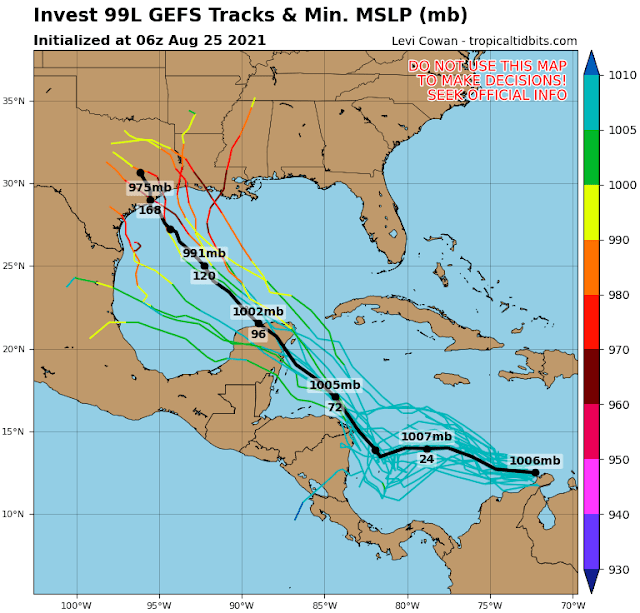
There's a lot of activity going on just between Grace and Henri. On Friday night, Hurricane Grace rapidly intensified right before making landfall in Mexico, reaching peak wind speeds of 125 mph (Category 3 hurricane)... the peak winds were just 70 mph (tropical storm) one day prior. That makes Grace the first major hurricane of the season. Then on Saturday morning, Henri finally became the season's third hurricane.
But before digging in to the storms, let's put both of those events in context. The average date of the third hurricane formation is September 7th, and the average date of the first major hurricane formation is September 1st. The ACE (Accumulated Cyclone Energy) is now at an impressive 181% of average for the date, well ahead of 2020's pace. The last year to top this level of activity by August 21st was way back in 2008.

I'll start with Grace since it will be brief. There was always a decent chance of rapid intensification (RI) with Grace, either before reaching the Yucatan peninsula or afterward in the Bay of Campeche. It waited until the very last possible moment to do it. RI can be defined several ways, but the conventional threshold is an intensity increase of at least 35 mph in a 24 hour period. Grace easily reached that with a 55 mph increase in a day. Now that it made landfall, it's rapidly weakening, already down to a minimal tropical storm. If it survives intact and reforms in the East Pacific, it will maintain the name Grace.

Now on to Henri. This is going to be a significant storm for the northeast, perhaps the most impactful in three decades since Hurricane Bob left imprints on the area's memory in 1991. There are hurricane warnings in effect for Long Island and Rhode Island and Connecticut for the first time in a decade (hurricane warnings were issued ahead of Irene in 2011, though it weakened to a tropical storm before reaching there). There will be coastal flooding from storm surge, inland flooding from rainfall, and lots of wind-related destruction and power outages across several states.
I will simply share some of the great products from the National Hurricane Center, starting with the track forecast and wind-related watches and warnings (left), and the probability of tropical storm force winds and their most likely arrival times (right). Notice that landfall is expected sometime on Sunday evening in the Long Island area, but damaging conditions should begin about half a day ahead of that. Such widespread strong winds will be devastating to trees, resulting in power outages, blocked roads, and crushed properties.

Storm surge will absolutely be a problem along hundreds of miles of coastline. As of now, peak surges are forecasted to be in the 3-5 feet ballpark. But, this brings me to storm tide, the sum of the regular astronomical tide and the storm surge. In October 2012, Sandy made landfall right at high tide, on a full moon... that exceptionally poor timing added about 3.3 feet to the resulting water levels. Henri will make landfall in the 6-8pm timeframe on Sunday, and several stations in the area have their high tide right around then too.

And finally, as people who remember Irene in 2011 can vouch for, heavy rain is a significant hazard that will also affect several states. Widespread areas could see 3-6 inches of rain, and isolated locations could see up to 10 inches. Rather than showing a map of forecast rainfall amounts, the map below is the flash flood risk over the next three days. This takes into account the expected rainfall, rainfall intensity, and existing ground conditions (i.e. Fred's recent heavy rain matters for flash flood potential).

















































